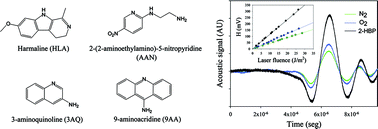Photoacoustic and luminescence characterization of nitrogen heterocyclic aromatic UV-MALDI matrices in solution†
Abstract
A group of

- This article is part of the themed collection: In honour of Professor Kurt Schaffner
* Corresponding authors
a
CIHIDECAR-CONICET, Departamento de Química Orgánica, Facultad de Ciencias Exactas y Naturales, Universidad de Buenos Aires, Pabellón II, 3 Ciudad Universitaria, (1428) Buenos Aires, Argentina
E-mail:
erra@qo.fcen.uba.ar
b
Centro de Investigaciones Ópticas-CIOp (CONICET-CIC) and Universidad Nacional de La Plata, Casilla de Correo 3, (1897) Gonnet, Argentina
E-mail:
gabrielb@ciop.unlp.edu.ar
A group of

 Please wait while we load your content...
Something went wrong. Try again?
Please wait while we load your content...
Something went wrong. Try again?
G. Petroselli, R. Erra-Balsells, P. David Gara and G. M. Bilmes, Photochem. Photobiol. Sci., 2012, 11, 1062 DOI: 10.1039/C2PP05388H
To request permission to reproduce material from this article, please go to the Copyright Clearance Center request page.
If you are an author contributing to an RSC publication, you do not need to request permission provided correct acknowledgement is given.
If you are the author of this article, you do not need to request permission to reproduce figures and diagrams provided correct acknowledgement is given. If you want to reproduce the whole article in a third-party publication (excluding your thesis/dissertation for which permission is not required) please go to the Copyright Clearance Center request page.
Read more about how to correctly acknowledge RSC content.
 Fetching data from CrossRef.
Fetching data from CrossRef.
This may take some time to load.
Loading related content
